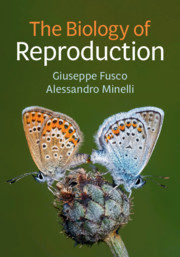Book contents
- The Biology of Reproduction
- The Biology of Reproduction
- Copyright page
- Contents
- Preface
- Figure Credits
- Introduction
- Chapter 1: Introductory Concepts
- Chapter 2: Reproduction and Life Cycle
- Chapter 3: The Natural History of Reproduction
- Chapter 4: Parental Investment in Sexual Reproduction
- Chapter 5: Genetics and Cytogenetics of Reproduction
- Chapter 6: Determination of Sex and Mating Type
- Chapter 7: Reproduction: a Taxonomic Survey
- Coda
- Appendix: A Classification of Living Organisms
- References
- Taxonomic Index
- Subject Index
Coda
Published online by Cambridge University Press: 30 September 2019
- The Biology of Reproduction
- The Biology of Reproduction
- Copyright page
- Contents
- Preface
- Figure Credits
- Introduction
- Chapter 1: Introductory Concepts
- Chapter 2: Reproduction and Life Cycle
- Chapter 3: The Natural History of Reproduction
- Chapter 4: Parental Investment in Sexual Reproduction
- Chapter 5: Genetics and Cytogenetics of Reproduction
- Chapter 6: Determination of Sex and Mating Type
- Chapter 7: Reproduction: a Taxonomic Survey
- Coda
- Appendix: A Classification of Living Organisms
- References
- Taxonomic Index
- Subject Index
Summary
We have come to the end of this excursion through the phenomena of reproduction. It was not a short trip, but the reader will certainly have realized that it could have been much longer. In every taxonomic group, reproduction involves a range of very different biological processes: from the creation of new genotypes to social behaviour, from resisting adverse environmental conditions to migration. Reproduction borders on these ‘other aspects’ of an organism’s biology and often trespasses into them. So what is it that is common to all these reproductive phenomena? In other words, what exactly, in the end, is reproduction?
- Type
- Chapter
- Information
- The Biology of Reproduction , pp. 404 - 406Publisher: Cambridge University PressPrint publication year: 2019

